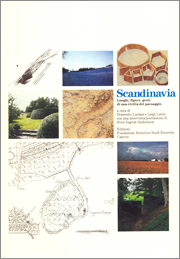
Scandinavia
Luoghi, figure, gesti di una civiltà del paesaggio
edited by Domenico Luciani and Luigi Latini
with an interview/afterword by Sven-Ingvar Andersson
Fondazione Benetton Studi Ricerche-Canova
Treviso 1998
292 pages, 130 illustrations in colour and 256 black and white
cover price 43.90euros
ISBN 88-8706-117-3
(Memorie, 5)
Premio Hanbury 1998
[Scandinavia. Places, people and actions in a culture of landscape]
In this mundus alter, where the Christian tradition is Protestant and the political tradition reformist and social democratic, the sense of nature is shot through with distinctive ideas, ethics and creativity, a certain conception of the world and even a religious vision of individual destiny.
The management of physical space here is based on the principle that any action that introduces change must tend towards the common good, to get as close as possible to accommodating pressures that are always contradictory, often conflicting and sometimes irreconcilable: the equilibrium of the natural environment; the form of the landscape; the functions of human settlements.
In the Scandinavian world this is what underlies the dialogue between the intentions of the commissioning party (public) and scientific, technical and artistic attitudes; they are united by a common commitment to society and a common “functionalist” propensity that operates on realty in order to change and improve it, not to contemplate or overwhelm it. These then are the cultural and political springs of what we may call “landscapism”: a creative and operative disciplinary area with recognizable features that make it separate from architecture, from town planning and from the natural sciences and technical subjects (even though it involves each of them).
The study covers several generations of Scandinavian “landscapism”, from Carl Theodor Sørensen to Gunnar Asplund and Sigurd Lewerentz, and from Sven-Ingvar Andersson to Steen Høyer and his contemporaries. We have brought together various points of view in an attempt to assemble the ideas, skills, educational influences, professions and regulations that govern Scandinavian “landscapism”. And we have tried to explore (in Materiali da un viaggio [Materials from a journey]) the reactions of an outsider, who know these places only as a visitor.
Scandinavia makes us aware of the existence of “landscapism” and it enables us to understand its scientific, artistic and operative independence. What emerges is a method, an authentic Nordic tradition of designing and governing landscape, a tradition that embodies (and updates) deeply rooted perceptions and states of mind that constitute elements of the historical identity of entire peoples.
The Scandinavian experience shows how an entire school has embraced modernity without losing contact with memory, how it has continued to experiment and, often with the talent to achieve success, to take up the challenge of giving shape to the “facial” features of our civilization.
The volume brings together a selection of the materials, considerations and later research prompted by the Fifth course on the stewardship of landscapes and gardens (20th August-3rd September 1994), which the Foundation dedicated to Scandinavia, its landscapes and the cultural approach underlying its attitudes. The editors of Scandinavia, Domenico Luciani and Luigi Latini, were awarded the 6th Hanbury botany and gardens prize (promoted by the Grinziane Cavour Prize) for “a book that introduces us to the innovative movement of thought and the dynamic activity of landscape and garden design in the Scandinavian world”.
Contents
Nota dei curatori, 9
I. Idee e strumenti nell’esperienza del paesaggismo nordico
Sven-Ingvar Andersson, Natura e civiltà nella tradizione nordica, 13
Marc Treib, Paesaggio sul limite, 17
Malene Hauxner, Natura e disegno del paesaggio nella mentalità scandinava, 30
Steen Høyer, Il contesto sociale, la formazione dell’architetto del paesaggio, le professioni connesse, 51
Steen Høyer, Il significato artistico dello spazio, 58
Annelise Bramsnæs, Architettura del paesaggio e pianificazione in Danimarca, 73.
II. Luoghi e momenti di identità nazionali
Thorbjörn Andersson, Erik Glemme e il sistema dei parchi di Stoccolma, 81
Magne Bruun, La forza della natura e la natura dei luoghi, 99
Magne Bruun, Gli insediamenti lacustri nella tradizione nordica, 109
Tom Simons, La natura prima di tutto, 115
III. Materiali da un viaggio
Massimo Venturi Ferriolo, La realtà come idea: immagini del paesaggio scandinavo, 128
Margherita Azzi Visentini, Il giardino in Scandinavia tra Rinascimento e Romanticismo, 133
Renzo Carniello, Hornborgasjön: un paesaggio ritrovato, 146
Franco Migliorini, Paesaggi urbani del nord, 154
Domenico Lucian, Lontano dalla città, il museo e il paesaggio, 164
Luigi Latini, Cimiteri scandinavi: un percorso attraverso l’esperienza del XX secolo, 173
IV. Figure del paesaggismo scandinavo
Gudmund Nyeland Brandt (1878-1945), scheda di Malene Hauxner, 197
Erik Gunnar Asplund (1885-1940), scheda di Caroline Constant, 200
Sigurd Lewerentz (1885-1975), scheda di Caroline Constant, 205
Carl Theodor Sørensen (1893-1979), scheda di Anne Whiston Spirn, 211
Sven Hermelin (1900-1984), scheda di Thorbjörn Andersson, 214
Erik Glemme (1905-1959), scheda di Thorbjörn Andersson, 216
Holger Blom (1906-1996), scheda di Thorbjörn Andersson, 218
V. Libri, riviste, scuole dei paesi nordici
Festskrift Tilegnet Sven-Ingvar Andersson, recensione di Domenico Luciani, 223
Malene Hauxner, Fantasiens Have, recensione di Margherita Azzi Visentin, 226
Caroline Constant, The Woodland Cemetery: Toward a Spiritual Landscape, recensione di Luigi Latini, 228
Strejf i dansk havekunst, a cura di Annemarie Lund e Solveig Stenholm, recensione di Mariapia Cunico, 230
Architecture danoise du paysage contemporain ou paysages musicaux, recensione di Annemarie Lund, 232
L’architettura del paesaggio nelle riviste scandinave, schede di Carla Bianchi, 234
Scuole di paesaggismo, 240
VI. La Foresta della Memoria
Sven-Ingvar Andersson, Il “Sacro Bosco” di Stoccolma, 251
Lionello Puppi, Il “Cimitero nel bosco” di Stoccolma e il Movimento Moderno, 253.
VII. Postfazione
Parole chiave da un’intervista a Sven-Ingvar Andersson, 261
Bibliografia citata, 277
Referenze sulle illustrazioni, 281
Indice analitico, 283
